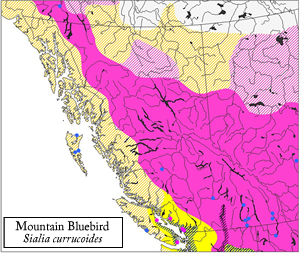Adult males, with their almost entirely sky blue plumage, are very distinctive and are unlikely to be confused with any other species. Male Western Bluebird is darker blue, with chestnut or rufous on the breast, sides, flanks, and scapulars. Adult females, however, do present some significant identification pitfalls, particularly brightly-coloured individuals with brighter and more extensive rufous-buff on the breast. Such individuals can easily be confused with female Western Bluebird, although the Mountain Bluebird can typically be distinguished by its relatively longer tail and longer primary projection which give it a slightly lankier overall shape. Female Western Bluebird also tends to have a brighter rufous-buff wash across the breast and sides (and sometimes extending onto the scapulars) than even the brightest female Mountain Bluebirds. Finally, female Mountain Bluebird typically shows bolder, paler pale feather edges on the wing feathers than female Western Bluebird, which tends to have relatively plainer wings. Juvenile Mountain Bluebird is best distinguished from juvenile Western Bluebird by its relatively less spotted or unspotted upperparts (juvenile Western Bluebird shows bolder and more extensive pale spotting on the back and scapulars).
| The song is given primarily during early morning hours and is infrequently heard. It consists of a short series of loud, emphatic phrases and is similar in structure to the song of the American Robin: chow, chow, poly-chow, poly-chow; this song is often given in flight. The male also sometimes gives a soft, repetitious, warbling eeee-ee-e. Calls include a soft, nasal, descending tew or peu and a short, harsh, high-pitched tink or chak. br>Source: Power and Lombardo (1996); Sibley (2000) |
Courtship
Pair formation occurs on the breeding grounds, with males arriving several days prior to females in order to set up breeding territories and select potential nest sites. Few courtship displays have been documented in this species, and it is unclear what mechanisms aid female mate choice.
Nest
This species typically nests in pre-existing cavities in snags, stumps, fenceposts, or nest boxes; nests are rarely placed in holes in earth banks, in old mammal burrows, in the old nests of other bird species (Barn Swallow, Cliff Swallow, American Robin, Dark-eyed Junco), in crevices in abandoned or active buildings, in rock talus, or in cavities in cliffs. Nest height ranges from 30 cm to almost 10 m, although most nests are between 1 and 2 m above the ground. Construction of the actual nest, which consists of a loose cup of grasses, strips of bark, and weed stems at the bottom of the nest cavity, is completed primarily by the female during April or early May. Nest construction generally takes between several days to a week or more.
Eggs
A clutch of (4) 5-6 (8) eggs is laid between mid-April (rarely as early as late March) and late May, and is incubated by the female (occasionally the male) for (12) 13-14 (15) days before hatching. Some pairs are double-brooded in B.C., with second clutches occurring between late May and late June (rarely early July); the latest clutches may even represent treble-brooded pairs, or may represent pairs that have lost one or more previous clutches. The smooth, glossy eggs are entirely pale bluish or bluish-white and are paler in colour than the eggs of the Western Bluebird. This species is a rare host for Brown-headed Cowbird parasitism. Eggs are present in B.C. between late March or early April and early August.
Young
The young are fully altricial and downy at hatching, with pinkish-grey skin, a yellow-orange mouth, and yellow gape flanges. The nestlings remain inside the nest cavity for 18-23 days, during which time they are tended by both parents. Following fledging, the young remain closely associated with their parents for several weeks before dispersing and becoming completely independent. Nestlings and dependent fledglings are present in B.C. between mid-April and mid-August, with most occurring between late May and late June.
Source: Power and Lombardo (1996); Baicich and Harrison (1997); Campbell et al. (1997)
|
This species feeds more extensively on invertebrates than most other thrushes, with insects and spiders often comprising more than 90% of the diet throughout the year. It also feeds on small amounts of plant material, such as seeds, fruits, and berries when they are available. A variety of foraging methods are employed, including perch-foraging, ground-foraging, flycatching, and hover-foraging. Foraging birds often perch on elevated, exposed perches in open habitats and fly to the ground to pursue or capture prey items. During hover-foraging, individuals hover momentarily above potential prey items before dropping to the ground for capture.
Source: Power and Lombardo (1996)
|
|

